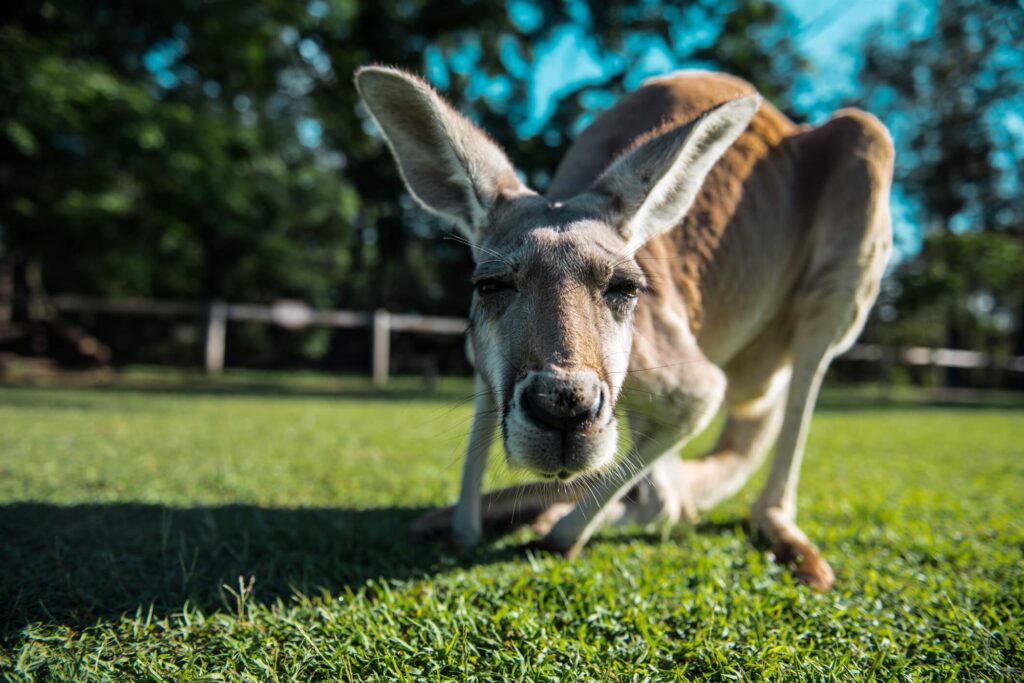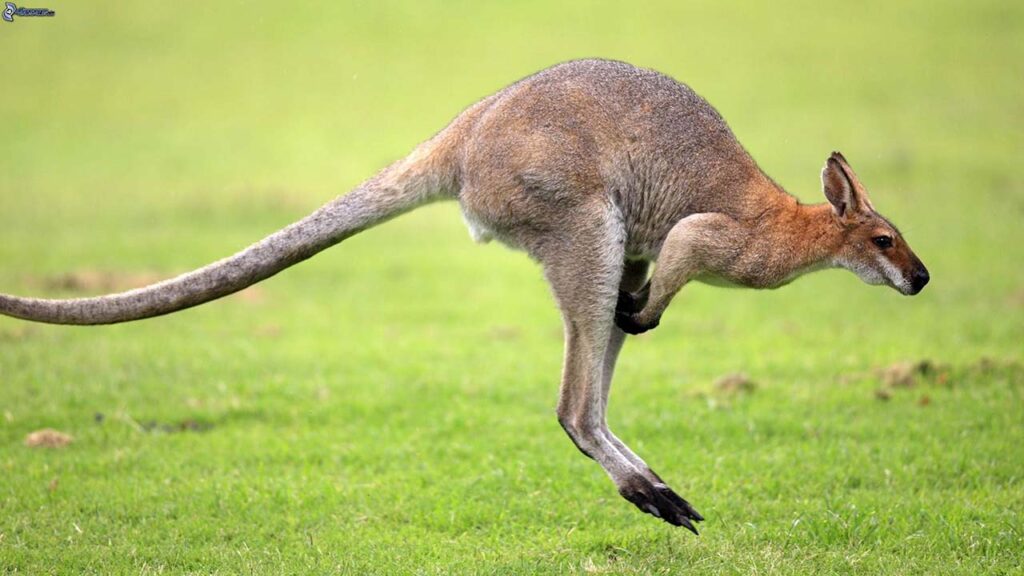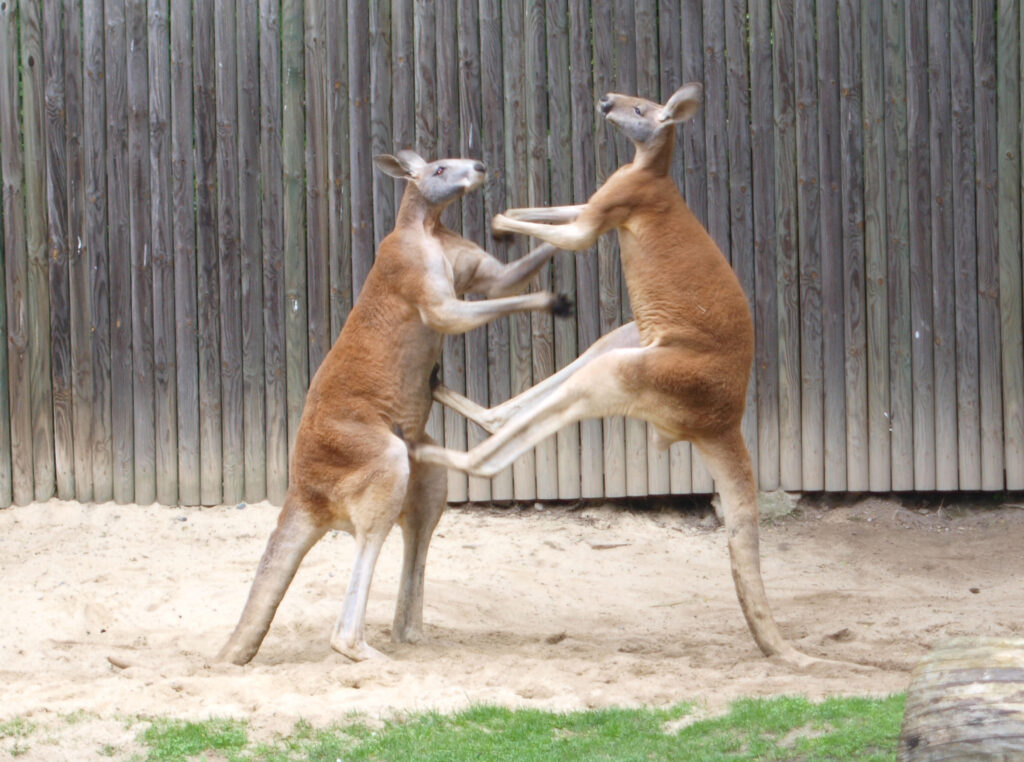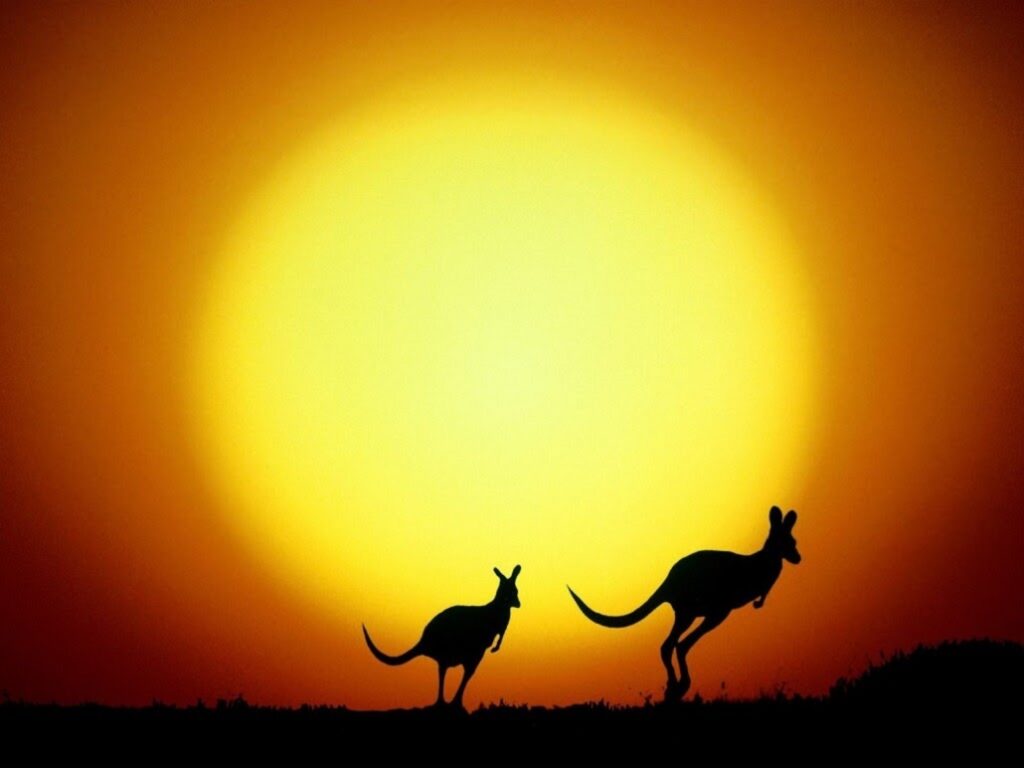Kangaroos are known as those typical Australian marsupials that have large and powerful hind legs and more than anything because of the incredible jumps they usually make. Another unique feature of the kangaroo is the pouch that the female has to carry her developing calf. Get to know in this reading other peculiarities of this curious and peculiar species.

The kangaroo
The kangaroo is a mammal of the marsupial order, (gen. Macropus), which has robust hind limbs and is suitable for jumping. In its evolved marsupio (bag where its young develops) it protects its little ones for several months until they achieve the form of adults. It is exclusively herbivorous and native to Australia.
The word kangaroo is the denomination that is frequently used to refer to the larger species of the subfamily Macropodinae, just as the term wallaby is used to call the smaller ones. It is also used, on occasions, in a broader or vast sense, to refer to almost all the members of the macropod family.
However, the term does not refer to a rigorous scientific classification, so varieties that are part of the same genus (group of closely related species) can be called kangaroo, wallaby or wallaby, which only depends on their size. . For example, Macropus parma is known as the Parma wallaby, while Macropus antilopinus is variously referred to as antelope kangaroo or antelope wallaby.
Name's origin
The term kangaroo comes from "gangurru", a word of the Guugu Yimithirr (Australian natives), with which they referred to the gray kangaroo. This word was first written (in its English version "kangaroo") by the expeditionary James Cook on August 4, 1770.
A widespread legend assures that the term kangaroo would have emerged when Westerners asked what that animal was called and thus being "Kan Ghu Ru" what the aborigines answered. According to the story, this did not mean the name of the animal, but rather they wanted to say «I don't understand him. This legend does not have a certain source, since the vernacular origin of the term is duly documented.
Kangaroo Varieties
The Macropodinae subfamily includes, in addition to the varieties of kangaroos, wallabies and wallaroos, others frequently referred to as tree kangaroos, koocas, dorcopsis and pademelons. There are numerous species called kangaroos, and four of them are reviewed here:
- The Red Kangaroo (Macropus rufus), this is the largest of the kangaroos and the largest of the species of marsupials still alive. Red kangaroos are found in central arid and semi-arid Australia. A male in his adulthood can reach 1,5 meters in height, 3 meters in length and a weight of 135 kilograms.
- The Eastern Gray Kangaroo (Macropus giganteus), is less known than the red kangaroo, but is more frequently observed, since its territory includes the fertile eastern area of Australia.
- The Western Gray Kangaroo (Macropus fuliginosus), smaller in size and located south of Western Australia, southern Australia near the coast and in the Darling River valley.
- Antilopine Kangaroo (Macropus antilopinus) it is basically the remote northern counterpart of the eastern and western gray kangaroos. Just like them, it is an animal of the plains, forests and gregarious.
Kangaroos are located primarily in Oceania, being popularly known as the most typical animal in Australia.
Description of the Kangaroo
Kangaroos have large and powerful hind legs, huge feet suitable for jumping, a long and muscular tail to maintain balance and a small head. Their wide ears are autonomous, that is, they can point them in different directions at the same time. The females have a marsupial bag to shelter and protect their modest young. His life expectancy is around 18 years.
Kangaroos are totally herbivorous, since their food consists of grass and roots. All of its varieties are active at night and at dusk since they usually spend the day calm to feed in the afternoons and cold nights, usually in groups. Kangaroos can reach a length of 3 meters and their tail serves as support, balance and even as a third lower extremity.
Kangaroo Feeding
Various herbs, small plants, leaves, flowers, ferns, mosses and various fruits are the main constituents of their diet. With this it is clear that they are eminently herbivores. They choose to seek their food in groups at the end of the afternoon and at night, being able to spend long periods of time without water..
Kangaroo Behavior
Their groups are large, since they can include 30 to 50 specimens spread over open land. If any sign of danger is noticed, they leave since they are shy species, but when it is time to face any threat, they become violent and use a curved and very sharp nail located on their hind limbs, with which they can severely injure the species. prey, accompanied by its peculiar jump to launch powerful kicks.
Locomotion
Kangaroos are the only large animals that move by hopping. They make such jumps by moving their legs at the same time, constituting a fast and economical form of locomotion, since at high speeds they consume only a small portion of the energy they would need if they moved in another way.
Because of the length of their feet, they cannot walk properly. To move at low speeds, they use their tails as a tripod, in conjunction with their front legs. That way they can move their feet one step forward.
When they run, they move at a speed of 20 to 25 km/h and when they require speed over short distances they reach up to 70 km/h, maintaining a speed of 40 km/h for at least two kilometers. They can jump up to 9 meters at amazing speeds and despite being great jumpers, they are unable to jump backwards.
Kangaroo Reproduction
Their reproductive cycle varies a lot according to the species. The red kangaroo is a breeder of opportunity, as it pairs and reproduces when seasonal conditions are favorable for its breeding. Gray kangaroos breed throughout the year, but spawn more pups in the summer months as they emerge from the pouch in the ideal season, spring. Other varieties have a more limited breeding season.
In numerous species, such as the quoca, mating occurs after childbirth (post partum estrus); For these occasions, a resting blastocyst is usually produced, which develops later, when the young from the previous birth leave the marsupium.
The courtship of the male with the female can last from a few hours to two or three days. The male follows the female kangaroo in heat, frequently sniffing at the opening of her urogenital sac, touching his long tail with one of her lower limbs.
The smaller ones, or wallabies, make sideways movements with their tails before copulation, generating clicks that attract the female's interest. Mating can last for a few minutes, or in contrast, in the case of the gray kangaroo, it can last up to an hour or more.
Some 28 to 36 days after mating, the offspring come into the world without having fully developed, without fur, with non-functional eyes and ears, and only three centimeters in size. In the case of red kangaroos, whose weight is about 27 kilograms, their young barely reach a weight of 800 milligrams.
Whenever the calf is released, it moves to its mother's pouch by moving its head to the sides as it crawls along the womb, then firmly takes the breast in its mouth, and the tip of it expands until it fills the oral cavity, all in a few minutes. There you will get your food for the next eight months. Being ready for the outside, it constantly returns to the sack for suckling for another six months, by which time another calf will have been born.
In most cases, only one offspring is born at a time, but births of two kangaroo offspring have been reported. The young are usually bonded with their mothers until they reach sexual maturity.
Kangaroo Threats
The natural predators of the kangaroo are few. The thylacine, once considered by paleontologists to be one of the most important predators of the kangaroo, has disappeared. Among other missing predators are the marsupial lion, the Megalania and the Wonambi. However, with the arrival of humans in Australia some 50.000 years ago and the introduction of the dingo some 5.000 years ago, kangaroos have had to adapt.
The simplest bark of a dog can shock an adult male into a wild frenzy. Eagles and other scavenger birds usually eat kangaroo carcasses. Goannas and other carnivorous reptiles also pose a risk to the tiniest classes of kangaroos when other food sources are not enough.
https://www.youtube.com/watch?v=VVyOXm01R_I
Together with dingoes and other canids, the incorporation of animals such as foxes and wild cats also becomes a threat to kangaroo groups. Kangaroos and wallabies are occasional swimmers, usually fleeing into streams if the opportunity arises.
When in the water, a large kangaroo can use its forelimbs to hold the predator underwater and drown it. Another defense tactic reported by witnesses is to hold the dog with the front limbs and kick it with the hind limbs.
Relationship with Humans
Larger kangaroos have adapted better to the changes brought about by humans in the Australian landscape, and although many of their smaller cousins are at risk of extinction, they are numerous.
They are not farmed to any extent, but hunting of wild kangaroos grew considerably for their meat, skins, sporting activities, and for the protection of sheep and cattle grazing grounds. Although there is some controversy, the harvesting of kangaroo meat has several benefits for the environment and health if it is equated with traditional meats.
The kangaroo is the national figure of Australia and its emblem is used on Australia's coat of arms, on several of its coins, as well as by certain well-known organizations in Australia, the kangaroo is of importance to both Australian culture and the image of the country, which is why there are numerous references to these animals in popular culture.
We also recommend these items:




